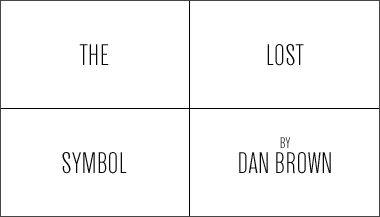 Sam Anderson
Sam Anderson- "The Dan Brown Reading Room: In which all is revealed."
- 09/22/09 at 12:05
FACT:
Dan Brown is a real living author. His book The Da Vinci Code sold more than 81 million copies.
The Lost Symbol is actually the title of Dan Brown’s new novel, not a parody title invented to make fun of how similar all of his novels are. It sold 1 million copies on its first day in stores.
All references to Dan Brown and his work in this Reading Room are accurate. The sentences excerpted from The Lost Symbol were actually written by Dan Brown.
*
New York Magazine book critic Sam Anderson closed his heavily marked-up copy of The Lost Symbol with a sudden sense of dread. Tugging absently on his thick black sideburns, he allowed his eyes to drift up to the framed photo of Edmund Wilson that hung over his desk. The greatest American critic of all time, he thought. You would have known exactly how to handle this, Bunny.
In his breathtakingly rapid climb to the pinnacle of the literary world, Anderson had become known for his strong, uncompromising opinions. “The Grim Reader,” one blogger had called him, referring to his penchant for swiftly and mercilessly sentencing subpar books to brutal critical deaths. The word “critic,” Anderson often told his students, came from the Latin for “decisive.” He usually finished books with a burst of confidence, ready to jot down a quick assessment on an index card and then file it away among tens of thousands of other cards in the climate-controlled critical archive of his 8,000-square-foot Brazilian-rosewood-paneled private library.
But tonight, in the wake of finishing Dan Brown’s follow-up to The Da Vinci Code, he felt haunted by an unfamiliar sensation: confusion.
The feeling terrified him.
He had no easy name for the strange mixture of emotions the book had raised in him: boredom, impatience, disdain ─ awe at Brown’s sheer stylistic clumsiness ─ but also excitement, hilarity, and sometimes even deep enjoyment. While it was obvious that The Lost Symbol wasn’t great literature, he wasn’t sure exactly what it was. A brilliantly trashy thriller or a terribly trashy thriller? Harmless fun or dangerous fantasy? Should he mock it for its literary shortcomings, praise it for its suspenseful plotting, or try to unpack it as some kind of unconscious compendium of the era’s deepest obsessions? And why did he find himself, in spite of his many reservations, mostly loving the Dan Brown experience?
He slumped forward in his custom-fitted Aeron chair, head resting on the elegantly hand-beveled surface of his massive Italian marble desk.
I need help.
His eyes drifted back to the photo of Edmund Wilson, the legendary critic whose belief in the mystical aspects of book reviewing made him both a hero to open-minded readers and an object of suspicion to the intellectual establishment.
Suddenly, the answer struck him like a powerful boxer’s jab to the chin.
A Vulture Reading Room.
He would assemble an elite squad of world-class critics to comb the text for its most revealing moments, collectively unveiling the lost secret of The Lost Symbol.
But who would be its members?
Heart pounding, Anderson took out a sheet of paper and drew a quadralinear grid. The ancient Foursquare of Communal Exegesis. In all his years as a book critic, he’d never had to use this. In fact, he’d always dismissed it as a myth. But tonight he saw no better option. Slowly, he filled in the grid:

Gibberish. Anderson had no idea how these unrelated figures were supposed to help him choose the members of his book club. Suddenly, all at once, it struck him like a roundhouse kick striking a kickboxer in the gut. Trans-intuitive anagrammatics ─ a mind-numbingly complex method, first pioneered by Wilson himself in a landmark unpublished interpretation of The Waste Land, in which letters are substituted more or less arbitrarily for other letters in order to yield the answers you were looking for in the first place.
His eyes flicked back to the photo.
Thanks, Bunny. I owe you one ─ again.
Anderson solved the code quickly, then raced to his black ThinkPad x60 and typed the invitations. As he clicked "send," he knew he was setting in motion a series of events that could not be stopped. But there was no choice. The time has come. All of literate culture, it seemed, was teetering precariously on the brink of doom ─ and everyone’s eyes were on this book. Perhaps the Vulture Reading Room would uncover an answer that would echo across the centuries.
The Vulture Reading Room members are:
• Renowned political journalist Matt Taibbi
• Renowned linguist Geoffrey K. Pullum, head of the linguistics department at the University of Edinburgh
• Renowned crime-fiction reviewer Sarah Weinman
• Renowned New York Magazine contributing editor Boris Kachka
• Renowned New York Magazine book critic Sam Anderson




